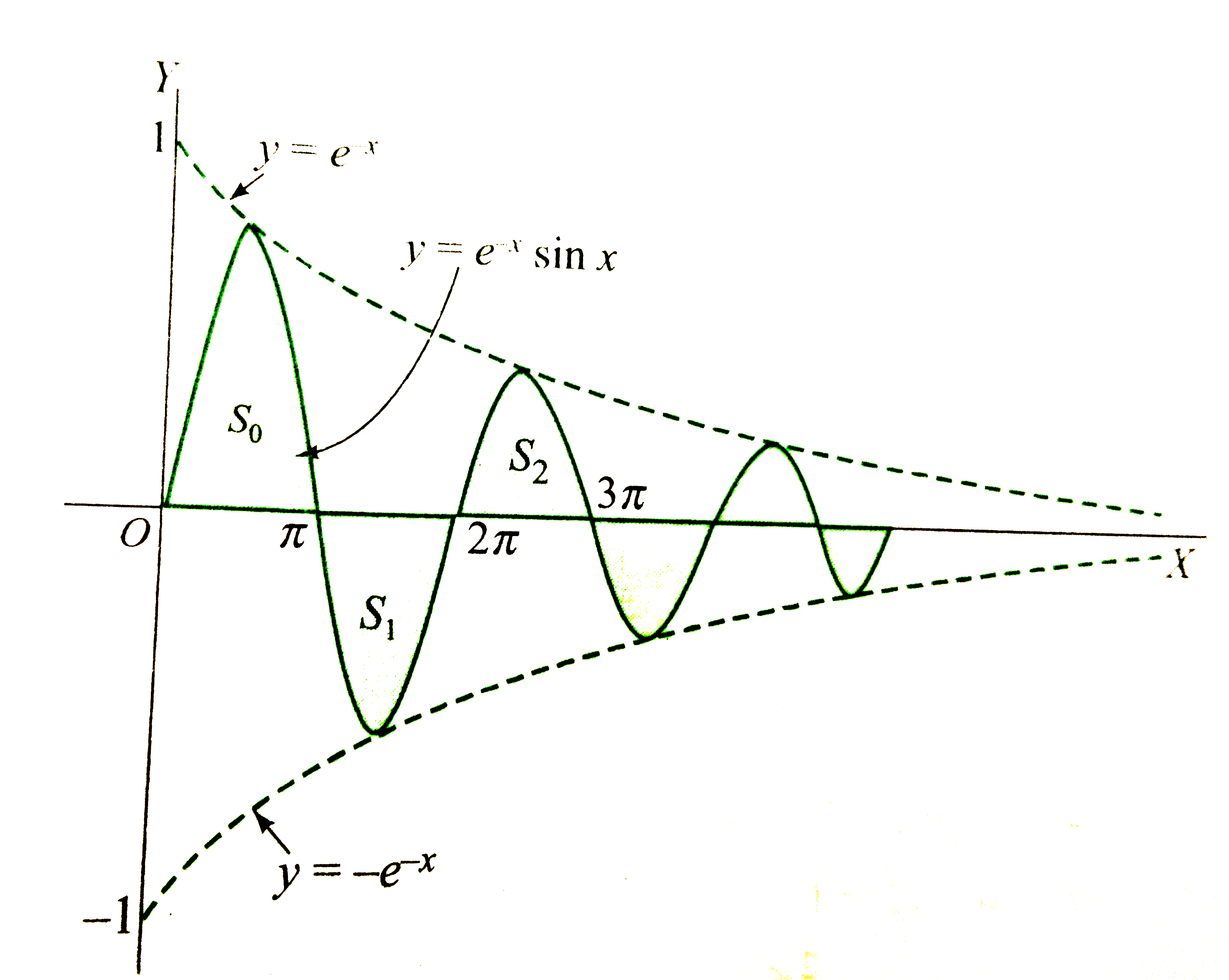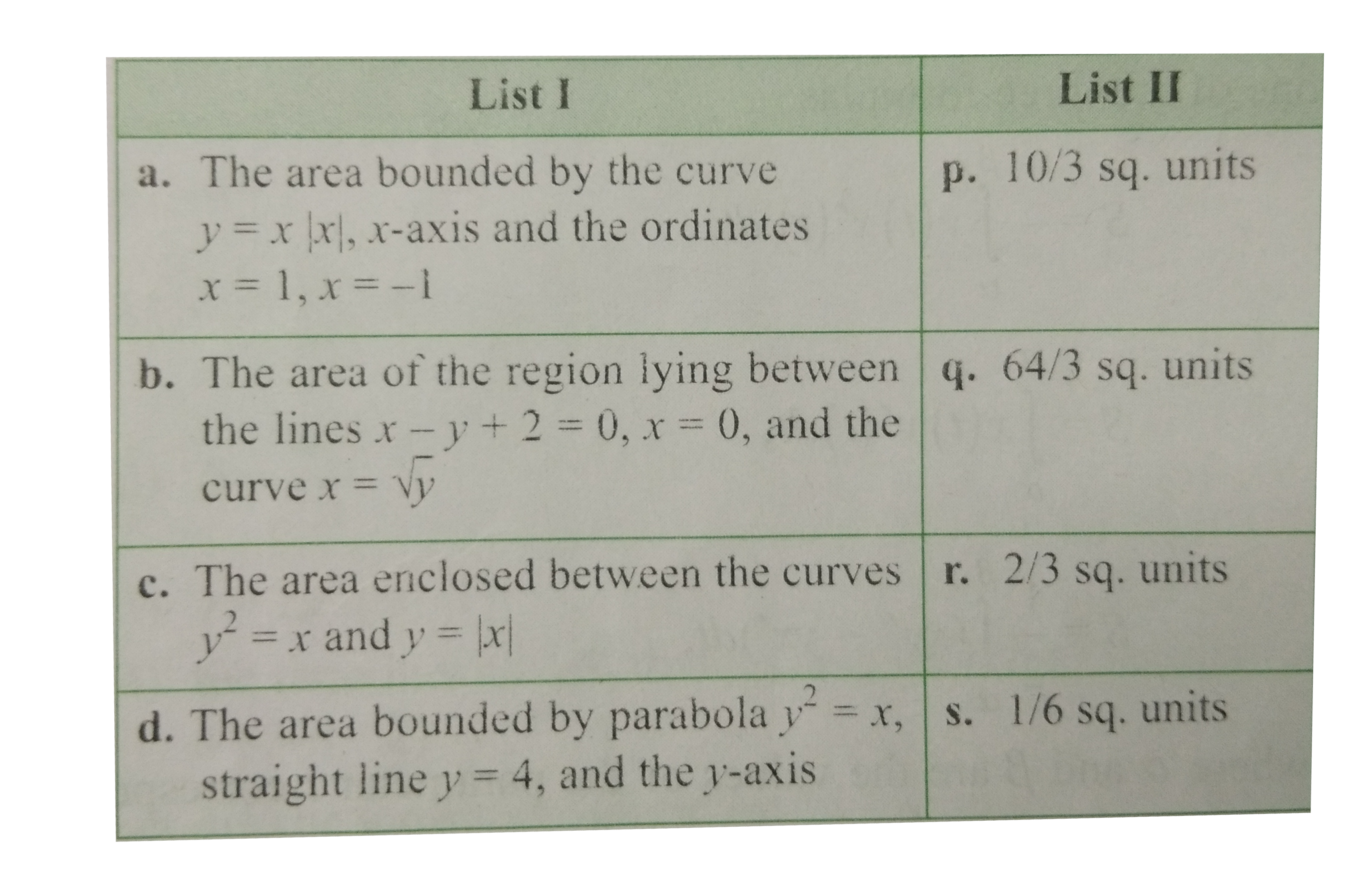Consider the area S0,S1,S2…. bounded by the x-axis and half-waves of the curve y=e−xsinx, where x≥0.
Σ∞n=0Sn is equal toSolution in Tamil
1+eπ1−e−π
12(1+eπ)1−eπ
12(1−e−π)
None of these
The correct Answer is:B
Since −1≤sinx≤1, the curve y=e−xsinx is bounded by the curve y=e−xandy=e−x.

Also, the curve y=e−xsinx intersects the positive semi-axis OX at the points where sin x=0, where xn=nπ,n∈Z.
Also |yn|=|y coordinate in the half-wave Sn|
∴ Sn=(−1)n(n+1)π∫nπe−xsinxdx
=(−1)n+12[e−x(−sinx+cosx)](n+1)πnπ
=(−1)n+12[e−(n+1)x(−1)n+1−enπ(−1)n]
=e−nπ2(1+eπ)
⇒ Sn+1Sn=e−π
and S0=12(1+eπ).
Therefore, the sequence S0,S1,S2,... forms an infinite G.P. with common ratio e−π. we have
∞Σn=0Sn=12(1+eπ)1−e−π
Topper's Solved these Questions
- AREABook:CENGAGEChapter:AREAExercise:Exercise (Matrix)
Explore 4 Videos
- AREABook:CENGAGEChapter:AREAExercise:Exercise (Numerical)
Explore 16 Videos
- AREABook:CENGAGEChapter:AREAExercise:Exercise (Multiple)
Explore 10 Videos
- APPLICATIONS OF DERIVATIVESBook:CENGAGEChapter:APPLICATIONS OF DERIVATIVESExercise:Subjective Type
Explore 2 Videos
- AREA UNDER CURVESBook:CENGAGEChapter:AREA UNDER CURVESExercise:Question Bank
Explore 10 Videos
Similar Questions
Match the following lists :

View SolutionThe area enclosed by the curve C:y=x√9−x2(x≥0) and the x-axis is___.
View SolutionLet A(k) be the area bounded by the curves y=x2−3 and y=kx+2 The range of A(k) is (10√53,∞) The range of A(k) is (20√53,∞) If function k→A(k) is defined for k∈[−2,∞ ), then A(k) is many-one function. The value of k for which area is minimum is 1.
View SolutionProve that for λ>1, the equation xlogx+x=λ has least one solution in [1,λ].
View SolutionThe area of the region (s) enclosed by the curves y=x2 and y=√|x| is
View SolutionConsider the sequence of natural numbers s_(0),s_(1),s_(2),... such that s_(0)=3,s_(1)=3 and s_(n)=3+s_(n-1)s_(n-2) then
View SolutionConsider the area S0,S1,S2…. bounded by the x-axis and half-waves of the curve y=e−xsinx, where x≥0.
The value of S0 is
View SolutionConsider the area S0,S1,S2…. bounded by the x-axis and half-waves of the curve y=e−xsinx, where x≥0.
Σ∞n=0Sn is equal to
View SolutionProve that the areas S0,S1,S2...bounded by the X-axis and half-waves of the curve y=e−axsinβx,x∣0.from a geometric progression with the common ratio g=e−πα/β.
View SolutionLet Sk=(1k01),k∈N.Then(S2)n(Sx)−1(where n in N) isequal to: (Sk)−1 denotes the inverse of matrix Sk
View SolutionIf S_(n) denotes the sum of first 'n' natural numbers then s_(1)+S_(2)x+S_(3)x^(2)+.........+S_(n) x^(n-1)+......oo=(1-x)^(-n) then n is
View SolutionIf s_(n) denotes the sum of first 'n' natural numbers then S_(1)+S_(2)x+S_(3)x^(2)+.........+S_(n)x^(n-1)+......oo=(1-x)^(-n) then n is
View SolutionIf S_(n) denotes the sum of first 'n' natural numbers then S_(1)+S_(2)x+S_(3)x^(2)+........+S_(n)*x^(n-1)+.....oo= then n is
View SolutionLet Sn the area of the figure enclosed by a curve y=x3(1−x3).0≤x≤1 and the x-axis. The value of limn→∞Sn is
View SolutionLet b be a positive constant. Let two curves S1:e−xy=1 and S2:exy=eb . Let A be the area of the part surrounding by S1,S2 and x=0 ,then limb→03A4b2 is equal to
View SolutionIf S0,S1,S2,… are areas bounded by the x-axis and half-wave of the curve y=sinπ√x, then prove that S0,S1,S2,… are in A.P…
View Solution